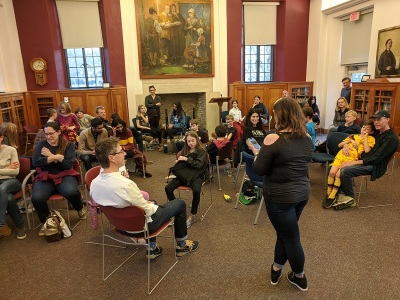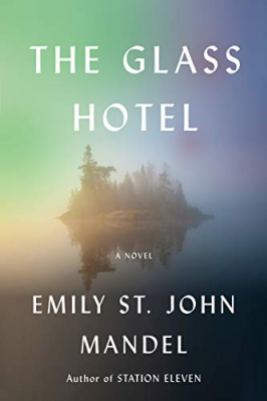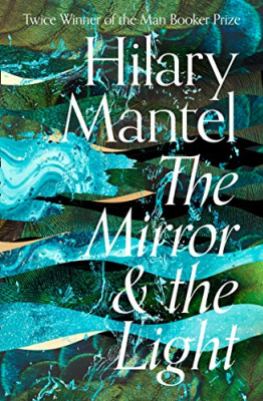Last Monday we were closed for Martin Luther King, Jr. Day, and next week I get to do a double storytime (2- and 3-year-olds on Monday as usual, preschool storytime on Tuesday), but this week was a regular Step into Storytime session. Attendance was on the low end to start with, about seven kids (all boys, coincidentally), but a few more came in during our initial songs and first few books.

- Welcome and announcements (including “storytime is my favorite part of the week.” I borrowed this lovely phrase from a librarian at the library in Arlington said this at her storytime last week. It is 100% true for me as well, as long as we’re talking about the work week)
- “Hello Friends” with ASL
- Name song (“___ is here today”)
- Goose by Laura Wall

- There’s A Dragon in Your Book by Tom Fletcher (this book encourages plenty of interaction: blowing out fire, popping a water balloon, etc.)
- Song cube: “The Wheels on the Bus”
- Pirate Jack Gets Dressed by Nancy Raines Day, illustrated by Allison Black: This is such a fabulous book to talk about colors (and getting dressed). I made a set of felt shapes to correspond to each item of Jack’s clothing and placed them on the felt board as we got to their page in the story. Before starting the book, we also took a look at what colors we were wearing.
- Mouse house game (by request). “Little mouse, little mouse, are you in the [color] house?” Apparently this never gets old!
- Song cube: “Zoom zoom zoom, we’re going to the moon” (twice)
- Make A Wish, Bear by Greg Foley: I had A Parade of Elephants with me too, but decided to save that for next week and made Bear the last book of today’s storytime. We noticed the star shapes on the cover and in the book, to tie in to our craft project.
- “Goodbye Friends” with ASL
- Invited questions, and one boy raised his hand and said, “I have a question! Will you put the paper out now?” (Later, a grown-up came up and asked for books for her kindergartener who likes funny books like Elephant & Piggie and Pigeon, so I helped her find several funny picture books.)
- Craft: Butcher paper taped to the floor, pre-cut colored construction paper stars, glue sticks, crayons.
And when I was finished cleaning up from storytime, the ALA Youth Media Awards had been announced! I was so excited to see that New Kid by Jerry Craft won the Newbery AND Coretta Scott King, and that Dig by A.S. King won the Printz, and Sal and Gabi Break the Universe by Carlos Hernandez won the Pura Belpré. Many other winner and Honor titles were books I’ve liked or loved this year:
- Other Words for Home by Jasmine Warga (Newbery Honor)
- Bear Came Along by Richard Morris and LeUyen Pham (Caldecott Honor)
- Look Both Ways by Jason Reynolds (Coretta Scott King Honor)
- What Is Given From the Heart by Patricia C. McKissack and April Harrison (Coretta Scott King/John Steptoe New Talent Illustrator Award)
- The Silence Between Us by Alison Gervais (Schneider Family Book Award Honor)
- Each Tiny Spark by Pablo Cartaya (Schneider Family Honor Book)
- Dominicana by Angie Cruz (Alex Award)
- The Swallows by Lisa Lutz (Alex Award)
- Children’s Literature Legacy Award to Kevin Henkes
- ALSC Children’s Literature Lecture Award to Dr. Rudine Sims Bishop (if you’re heard of mirrors, windows, and doors in children’s literature, she is why)
- Hey, Kiddo by Jarrett Krosoczka (Odyssey Award for best audiobook, though I read the print edition)
- We Are Grateful: Otsaliheliga by Traci Sorrell (Odyssey Honor; American Indian Youth Literature Picture Book Honor)
- We’re Not From Here by Geoff Rodkey (Odyssey Honor)
- ¡Vamos! Let’s Go to the Market by Raúl Gonzalez (Belpré Illustrator Honor Book)
- Planting Stories: The Life of Librarian and Storyteller Pura Belpré by Anika Aldamuy Denise and Paola Escobar (Belpré Author Honor Book)
- Fry Bread: A Native American Family Story by Kevin Noble Maillard and Juana Martinez-Neal (Sibert Award; American Indian Youth Literature Picture Book Honor)
- This Promise of Change: One Girl’s Story in the Fight for School Equality by Jo Ann Allen Boyce and Debbie Levy (Sibert Honor)
- Hey, Water! by Antoinette Portis (Sibert Honor)
- Chick and Brain: Smell My Foot! by Cece Bell (Theodor Seuss Geisel Honor)
- The Book Hog by Greg Pizzoli (Theodor Seuss Geisel Honor)
- Bilal Cooks Daal by Aisha Saeed (Asian/Pacific American Picture Book Honor)
- Stargazing by Jen Wang (Asian/Pacific American Award for Children’s Literature)
- Frankly in Love by David Yoon (Asian/Pacific American Young Adult Literature Honor)
- Indian No More by Charlene Willing McManis with Traci Sorell, cover art by Marlena Myles (American Indian Youth Literature Middle Grade Award)
…and naturally I added several others to my to-read list this morning. Congratulations to all the authors and illustrators, thanks to the committee members, and happy reading to everyone! | School Library Journal ALA YMA announcement














